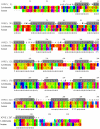A unique modification of the eukaryotic initiation factor 5A shows the presence of the complete hypusine pathway in Leishmania donovani
- PMID: 22438895
- PMCID: PMC3306375
- DOI: 10.1371/journal.pone.0033138
A unique modification of the eukaryotic initiation factor 5A shows the presence of the complete hypusine pathway in Leishmania donovani
Abstract
Deoxyhypusine hydroxylase (DOHH) catalyzes the final step in the post-translational synthesis of an unusual amino acid hypusine (N(€)-(4-amino-2-hydroxybutyl) lysine), which is present on only one cellular protein, eukaryotic initiation factor 5A (eIF5A). We present here the molecular and structural basis of the function of DOHH from the protozoan parasite, Leishmania donovani, which causes visceral leishmaniasis. The L. donovani DOHH gene is 981 bp and encodes a putative polypeptide of 326 amino acids. DOHH is a HEAT-repeat protein with eight tandem repeats of α-helical pairs. Four conserved histidine-glutamate sequences have been identified that may act as metal coordination sites. A ~42 kDa recombinant protein with a His-tag was obtained by heterologous expression of DOHH in Escherichia coli. Purified recombinant DOHH effectively catalyzed the hydroxylation of the intermediate, eIF5A-deoxyhypusine (eIF5A-Dhp), in vitro. L. donovani DOHH (LdDOHH) showed ~40.6% sequence identity with its human homolog. The alignment of L. donovani DOHH with the human homolog shows that there are two significant insertions in the former, corresponding to the alignment positions 159-162 (four amino acid residues) and 174-183 (ten amino acid residues) which are present in the variable loop connecting the N- and C-terminal halves of the protein, the latter being present near the substrate binding site. Deletion of the ten-amino-acid-long insertion decreased LdDOHH activity to 14% of the wild type recombinant LdDOHH. Metal chelators like ciclopirox olamine (CPX) and mimosine significantly inhibited the growth of L. donovani and DOHH activity in vitro. These inhibitors were more effective against the parasite enzyme than the human enzyme. This report, for the first time, confirms the presence of a complete hypusine pathway in a kinetoplastid unlike eubacteria and archaea. The structural differences between the L. donovani DOHH and the human homolog may be exploited for structure based design of selective inhibitors against the parasite.
Conflict of interest statement
Figures





References
-
- Park MH, Cooper HL, Folk JE. The biosynthesis of protein-bound hypusine (N epsilon -(4-amino-2-hydroxybutyl)lysine). Lysine as the amino acid precursor and the intermediate role of deoxyhypusine (N epsilon -(4-aminobutyl)lysine). J Biol Chem. 1982;257:7217–7222. - PubMed
-
- Murphey RJ, Gerner EW. Hypusine formation in protein by a two-step process in cell lysates. J Biol Chem. 1987;262:15033–15036. - PubMed
-
- Chen KY, Dou QP. FEBS Lett 229: 325–328. 0014-5793(88)81149-9 [pii]; 1988. NAD+ stimulated the spermidine-dependent hypusine formation on the 18 kDa protein in cytosolic lysates derived from NB-15 mouse neuroblastoma cells. - PubMed
Publication types
MeSH terms
Substances
Grants and funding
LinkOut - more resources
Full Text Sources
Molecular Biology Databases

